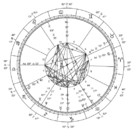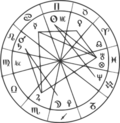Unsolved:Natal astrology
| Astrology |
|---|
| Background |
| Traditions |
| Branches |
Natal astrology (also known as genethliacal astrology) is a system of astrology that claims to be able to help shed light on an individual’s personality or path in life.[1] The concept is based on constructing a natal chart for the exact date, time, and location of that individual's birth. Natal astrology can be found in the Indian or Jyotisha, Chinese and Western astrological traditions.
In horoscopic astrology, an individual's personality is determined by the construction of the horoscope or birth chart for the particular individual involved (known as the native) showing the positions of the sun, moon, planets, ascendant, midheaven, and the angles or aspects among them.
Once the horoscope has been constructed the process of interpretation can begin, which involves building a complete picture of the personality of the subject. Interpretation involves three main steps: noting the important features of the chart, and the processes of chart weighting and chart shaping. Chart weighting involves noting the distribution of zodiac signs and houses in the chart, and the significance of this to the overall personality of the native. Chart shaping involves assessing the placement of the planets by aspect and position in the chart, and noting any significant patterns which occur between them.
Astrology is generally considered a pseudoscience by the scientific community. What little statistical evidence exists fails to show a causation between natal birth charts and real world consequences.
Important features
The important features of every chart to which an astrologer usually gives special attention are the positions of the sun and moon by sign and house, the sign on the ascendant, and the planet that rules that sign, called the ascendant ruler or chart ruler. Also considered important is the first planet to occupy the first, second, or third houses after the ascendant, called the rising planet. This is claimed to be a particularly strong influence in the chart. If no planet occupies the first three houses, then a planet in the twelfth house close to the ascendant can be taken to be the rising planet. Planets that are in conjunction to (right beside) the primary angles of ascendant, midheaven, descendant, or IC (known as angular planets) are also especially considered.
Chart weighting
Chart weighting begins by listing the sun, moon, planets, ascendant, and midheaven by categories of sign and house and noting the significant categories which appear. For example, a large number of planets appearing in fire signs will give importance or 'weight' to fire sign attributes in the native's personality.[2]
Weighting by sign
Chart weighting by sign lists the zodiac signs by three main categories - by masculine or feminine signs; by element (fire, earth, air and water) and by quality (cardinal, fixed and mutable). Some astrologers use all ten or eleven planets in the list and nothing else; while others include the ascendant and midheaven, but exclude the modern planets Uranus, Neptune and Pluto on the grounds that their influence is felt by whole generations and so their position by sign cannot have much significance in the individual chart. [3]
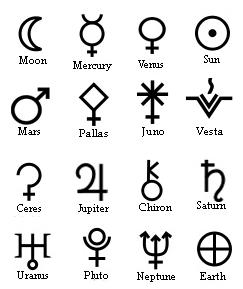
| Sign | Symbol | Element | Quality |
| Aries | 20px | Fire | Cardinal |
| Taurus | 20px | Earth | Fixed |
| Gemini | 20px | Air | Mutable |
| Cancer | 20px | Water | Cardinal |
| Leo | 20px | Fire | Fixed |
| Virgo | 20px | Earth | Mutable |
| Libra | 20px | Air | Cardinal |
| Scorpio | 20px | Water | Fixed |
| Sagittarius | 20px | Fire | Mutable |
| Capricorn | 20px | Earth | Cardinal |
| Aquarius | 20px | Air | Fixed |
| Pisces | 20px | Water | Mutable |
- Masculine (Fire and Air signs): The masculine signs are Aries, Gemini, Leo, Libra, Sagittarius, and Aquarius. A native with these signs predominating will tend towards extroversion, confidence and assertiveness, and have the ability to solve problems with courage and enterprise.
- Feminine (Earth and Water signs): The feminine signs are Taurus, Cancer, Virgo, Scorpio, Capricorn, and Pisces. A native with these signs predominating will tend towards introversion, shyness and passivity, and have the ability to nurture, conserve and solve problems by intuitive means.
- Fire: The fire signs are Aries, Leo, and Sagittarius. A native with mainly fire signs will be energetic, enthusiastic and optimistic, with a need to be in the center of the action making things happen. They can be egotistical, headstrong and sometimes arrogant, but also can be generous, warm-hearted, and spontaneously kind. Fire subjects are independent and prefer to have control over their own lives, but they can also be sometimes autocratic. A subject lacking fire signs will be fearful or over-cautious, pessimistic and shy, and will lack enthusiasm, confidence and faith in the future. Planets in the 1st, 5th and 9th houses and an emphasis on cardinal signs in the chart will help to compensate for this lack.
- Earth: The earth signs are Taurus, Virgo, and Capricorn. A native with mainly earth signs will be practical and cautious, sensible and capable and will be happier with concrete things than abstract ideas. They move slowly and carry out their work in a thorough and unhurried manner. Earth subjects are shrewd and careful and need emotional and material security, and will put up with quite a lot to get it. They are generous to those they love, but are otherwise careful not to waste time or money, though there can be a tendency towards meanness. Earth subjects tend to be shy in social situations, and to be slow to commit in love relationships, but are serious when they do. A subject lacking earth signs will lack common sense and practicality and find it difficult to finish anything they start. They may be scatty, unrealistic and clumsy, hopeless with money and unreliable. Planets in the 2nd, 6th and 10th houses and an emphasis on fixed signs in the chart will help to compensate for this lack.
- Air : The air signs are Gemini, Libra, and Aquarius. A native with mainly air signs will be an excellent communicator, concerned with ideas and theories of all kinds. They are looking for answers to life's questions and make good teachers and writers. Air people are more tense than they appear at first sight and may live on their nerves. They have many friends and acquaintances but may not be particularly interested in family life. They are interested in the latest technologies and are able to do a number of things at once. Air subjects are also very imaginative and quick-witted, but may be sarcastic and rude. A subject lacking air signs will have little imagination and lightness of touch. They have an over-emphasis on practicalities and can lack a sense of humour, and be boring company. They can find it difficult to communicate or to assimilate and explain new ideas. Planets in the 3rd, 7th and 11th houses, and an emphasis on mutable signs in the chart will help to compensate for this lack.
- Water: The water signs are Cancer, Scorpio, and Pisces. A native with mainly water signs will be very emotional and find it hard to look at anything dispassionately. They tend to respond slowly to questions and need time to grasp a new concept. Water subjects can find it difficult to explain their feelings, and so can be difficult to live with, but they are also kind and sympathetic to those they love. They need to give and receive a lot of affection and will direct it towards family, close friends and animals. A subject lacking water may lack intuition and be unable to see the needs of others. They may be too full of ideas or too fond of the material world to consider their own spiritual needs or those of other people. Planets in the 4th, 8th and 12th houses in the chart will help to compensate for this lack.
- Cardinal: The cardinal signs are Aries, Cancer, Libra, and Capricorn. A native with mainly cardinal signs will not want to be held under anybody's thumb, and will need to take charge of their own world. Their attention may be concerned with themselves or others, but wherever their energies are directed it is difficult to deflect them from their chosen course. Cardinal signs in a chart will add courage, initiative and self-motivation. Cardinal subjects are hard to influence because they generally believe they know best. A subject lacking cardinal signs may feel they are never in control of their own lives, but are manipulated by people and circumstances beyond their control. They may lack courage and initiative and may prefer others to make decisions for them. Planets in the 1st, 4th, 7th and 10th houses, and an emphasis on fire and air signs in the chart will help to compensate for this lack.
- Fixed: The fixed signs are Taurus, Leo, Scorpio, and Aquarius. A native with mainly fixed signs has the strength and endurance to see things through and to uphold the status quo. They need stable homes, careers and partnerships and prefer the known to uncertainty. Fixed subjects are loyal and dependable but can be very obstinate. A subject lacking fixed signs cannot stick with anything or see anything through, and will tend to walk away from problems. They may be too easily bored or too busy chasing rainbows ever to make anything substantial happen. Planets in the 2nd, 5th, 8th and 11th houses, or an emphasis on earth in the chart will help to compensate for this lack.
- Mutable: The mutable signs are Gemini, Virgo, Sagittarius, and Pisces. A native with mainly mutable signs are adaptable, co-operative and friendly. They can fit into almost any situation, put up with anything and turn any situation to their advantage. Mutable people can steer projects through periods of transition and bring them to a successful conclusion. Although gentle and likeable, mutable subjects seem to have more than their fair share of problems and can be selfish and ruthless when they feel threatened. These subjects may devote their lives to helping others, but they can often paradoxically be surprisingly selfish at the same time. Subjects lacking mutable signs may be unable to adapt to any kind of change and be particularly unhappy when faced with uncertainty. They need much notice before they will commit themselves to anything, and lack flexibility and adaptability. They may also hold onto rigid and unchanging views. Planets in the 3rd, 6th, 9th and 12th houses will help to compensate for this lack, and water signs in the chart will make up for the lack of intuition.
Chart signature
Some astrologers summarise the process of weighting by sign through creating what is called the chart signature.[4] This involves noting which element and quality has the most signs and then combining them into a zodiac sign which is taken to be the signature sign of the chart. So for example, if a person has more fire signs than any other element, and more fixed signs than any other quality, then that person's signature is Leo (the sign which is both fire and fixed).
In some cases there is no clear majority in either element or quality to give a clear signature. In these cases the ruling planet of the sun is noted for its position in the chart (alternatively, the ascendant can be added at this stage if it has not already been included). Whatever sign the ruling planet occupies is then added to the totals for element and quality. So for example, if the Sun is in Taurus, its ruling planet Venus is noted for its position by sign. If Venus is in, say, Pisces, then an additional 'casting vote' is given to the element water and quality mutable. This is usually enough to provide a signature. A 'casting vote' is given in this way on account of the extra importance of the Sun in the natal chart. The signature sign is regarded by those astrologers who use it as frequently having an over-riding influence in the natal chart, irrespective of what sign the sun or ascendant occupies.
Weighting by house
- Angular houses : These are the 1st, 4th, 7th, and 10th houses. Planets in these houses exert a strong influence on the subject, and may compensate for a lack of cardinal signs, and strength, courage and enthusiasm elsewhere in the chart.
- Succedent houses : These are the 2nd, 5th, 8th and 11th houses. These houses are concerned with possessions and creative pursuits, either by those of the subject alone, or with others. Planets in these houses may help to compensate for a lack of fixed signs in the chart.
- Cadent houses : These are the 3rd, 6th, 9th and 12th houses. Planets in these houses have a lot to do with the subject developing their own unique talents and aptitudes; and may compensate for a lack of mutable signs, and general adaptability in the chart.
Chart shaping
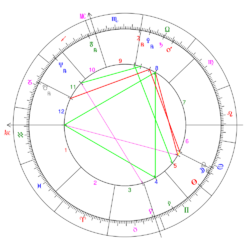
Chart shaping involves examining the placement of the planets in the chart by the aspects they form and by their positioning in the chart relative to one another. Any significant patterns or 'shapes' which occur in the chart are then interpreted for their importance to the personality of the native.
Aspect patterns
While the astrologer must note every aspect formed by the planets, aspects can be grouped together into larger patterns which must be given particular attention in the chart. The main aspect patterns are as follows:[5]
- Stellium: At least three planets linked together in a series of continuous conjunctions. The planets will act as if they are all in conjunction with each other, even if not all of them actually are. This pattern gives a huge emphasis to the sign occupied by the planets, regardless of the sun sign.
- Grand trine: Three trine aspects together. Indicative of a person at ease with him or herself, with strong inner harmony, talents and abilities. However it may make a person unable to cope with any real adversity, and may produce a weak, apathetic and condescending character.
- Grand cross: Two pairs of opposing planets squared to each other. Often proves to be a "make or break" pattern; either the person develops unusual strength of character, or feels crushed by life. Person will have "a cross to bear".
- T-Square: Two planets in opposition squared to a third. The tension typical of the opposition aspect is aggravated by additional problems introduced by the third planet. Often an obstructive feature blocking the normal flow of behaviour of the person. Person needs to develop activities represented by the "missing" arm of the T-square to achieve wholeness.
- Yod: Two quincunxes together joined by a sextile. It indicates restlessness and instability. The person gets drawn into the lives of others in ways that are difficult to avoid, with periodic crises and urgent calls for assistance.
Hemispheres
The houses are grouped into four main categories or hemispheres.[6] Horoscopes appear 'upside down' in relation to how the compass points usually appear, with the ascendant marking the eastern horizon traditionally appearing on the left hand side. For this reason the southern hemisphere appears in the upper part of the horoscope.
- Upper (southern) hemisphere The 7th, 8th, 9th 10th, 11th and 12th houses. A subject with most of his or her planets in this hemisphere will not be too deeply affected by the actions of other people. He or she will be able to distance themselves from those around them and from public events and movements, focusing firmly on their own needs and feelings, or the general cause of humanity that is important to them. If the planets are grouped in the 8th, 9th or 12th houses, the subject will have strong spiritual needs and values. Planets grouped in the 10th house will make the subject ambitious and politically astute; while if they are in the 11th house he or she will be interested in humanitarian causes and education.
- Lower (northern) hemisphere The 1st, 2nd, 3rd, 4th, 5th and 6th houses. A subject with most of his or her planets in this part of the chart will be sensitive to the moods and feelings of others, and may suffer a good deal as a result. The person may try to live through their family rather than for themselves, and may be too subjective in their thinking. They may also choose to do most of their thinking and working at home.
- Eastern hemisphere The 10th, 11th, 12th, 1st, 2nd, 3rd houses. A subject who has most of his or her planets in this hemisphere will be a self-starter who chooses their own path through life and sets their own boundaries. They are not happy being a burden to other people, or being kept by someone else. They also have the burden themselves of being an initiator at work and in their personal life, as little is likely to be done for them by others. When the planets are in the 1st, 2nd and 3rd houses, the subject is likely to be very self-absorbed and convinced that his or her own opinions are the only ones that matter.
- Western hemisphere The 4th, 5th, 6th, 7th, 8th, and 9th houses. A subject with most of these planets in this hemisphere will need to be very diplomatic in order to keep those around him on their side. They may be looked after in some way by others, or else spend their lives supporting and motivating others. When the majority of planets are in the 6th, 7th and 8th houses he or she will use their energy to fulfil the needs to others. The subject may bring about a situation of being needed by bringing a number of children into the world to love and care for.
Jones patterns
The American astrologer Marc Edmund Jones has listed seven significant patterns which also occur in the chart, based on the positions of the planets relative to one another.[7]
- Bundle : In this pattern the planets are grouped together so that they form a 'bundle' within the space of 120 degrees, or the equivalent of four signs of the zodiac. This intense concentration of planets produces a person who is equally intense and unrelenting in pursuit of personal interests. Perspective and understanding of others is limited, and it is difficult for this person to share their lives with anyone. The best course of life for such a person is to enter into enterprises that require deep concentration, persistence and commitment, or to specialise in one area of expertise.
- Bowl : In this pattern the planets are grouped into a 'bowl' of one hemisphere of 180 degrees, or the equivalent of six zodiac signs. The pattern will have particular force if all the planets are contained within one hemisphere. A person with this pattern will be self-contained, and go in search of enterprises that are meaningful, fulfilling and personally relevant. They tend to have a ministerial quality that seeks the right kind of career or vocation that will produce the greatest benefit for themselves and others.
- Bucket : This pattern is similar to the bowl except that one of the planets is in the opposite hemisphere to all the others. This lone planet, or Singleton, serves as a handle, thus creating a 'bucket' form. The bucket pattern indicates a desire to become associated with activity in the mainstream of society, so that the person feels they belong. However, what this often means is that the person expects the world to discover their own unique talents, rather than them trying to fit in. They will usually direct their efforts to a single purpose, and strive to achieve objectives rather than act solely for their own self-preservation. The person will probably behave according to the nature of the Singleton planet that forms the handle of the pattern. This planet will exercise a greater influence than normal in the chart, and will be an important part of the dynamic of the person's activities and basic energy.
- Seesaw : In this pattern the planets form two groups on opposite sides of the chart, the groups no less than sixty degrees or two signs apart. As its name suggests, this produces a person who behaves like a 'seesaw', with their life following a pattern of two distinctly contrasting alternatives. The person can find it difficult to integrate these two sharply different parts of their life, which are often in competition with each other. However, success produces the increased sophistication and polished, knowing demeanour of a person who is able to deal with most of life's situations.
- Locomotive : This pattern is produced when all the planets are contained within 240 degrees or nine signs of the zodiac, so that a whole 120 degrees is completely unoccupied. The planet that rises clockwise following the empty space will significantly influence the life of the person with this pattern, no matter what is indicated by the sun sign. It will act as the 'locomotive' of the natal chart, driving the individual to achieve goals through determined and unrelenting effort, with an exceptional drive and fund of energy at their disposal. Such a person will often be a loner, waiting for the public to discover the truth of what they have been saying all along.
- Splay : This type of natal chart is noteworthy because of the presence of at least two, but usually three pairs (or conjunctions) of planets randomly distributed in a 'splay' shape around the chart. A person with this pattern will have enormous talent and potential that needs deliberate attention to be developed into worthwhile skills. The person will be an individualist, with no desire for a regimented or highly organized way of life, and they will seek to avoid becoming trapped in routine. However, there is often the difficulty that there is a lack of relevance between the different skill sets, so that the person may not derive the full benefit from them. Such a person needs to concentrate on 'getting their act together'.
- Splash : As its name suggests this pattern, or rather lack of pattern, occurs when the planets are randomly distributed around the chart in a 'splash'. A person with this pattern will have diversification as their number one asset, with a universal and enriching mental outlook on life. The person will be eager to share their life and resources as universally as possible, wherever the need is greatest. However, as with the splay pattern, there is a danger of the person scattering their energy unproductively.
Scientific appraisal
Carlson's experiment
Shawn Carlson's double-blind chart matching tests, in which 28 astrologers agreed to match over 100 natal charts to psychological profiles generated by the California Psychological Inventory (CPI) test, is one of the most renowned tests of astrology.[8][9] The experimental protocol used in Carlson's study was agreed to by a group of physicists and astrologers prior to the experiment.[10] Astrologers, nominated by the National Council for Geocosmic Research, acted as the astrological advisors, and helped to ensure, and agreed, that the test was fair.[9]:117[11] :420 They also chose 26 of the 28 astrologers for the tests, the other 2 being interested astrologers who volunteered afterwards.[11]:420 The astrologers came from Europe and the United States.[9]:117 The astrologers helped to draw up the central proposition of natal astrology to be tested.[11]:419 Published in Nature in 1985, the study found that predictions based on natal astrology were no better than chance, and that the testing "clearly refutes the astrological hypothesis".[11]
Dean and Kelly
The scientist and former astrologer Geoffrey Dean and psychologist Ivan Kelly[12] conducted a large scale scientific test, involving more than one hundred cognitive, behavioural, physical, and other variables, but found no support for astrology.[13] Furthermore, a meta-analysis was conducted pooling 40 studies involving 700 astrologers and over 1,000 birth charts. Ten of the tests, which had a total of 300 participating, involved the astrologers picking the correct chart interpretation out of a number of others which were not the astrologically correct chart interpretation (usually 3 to 5 others). When the date and other obvious clues were removed, no significant results were found to suggest there was any preferred chart.[13]:190 A further test involved 45 confident[lower-alpha 1] astrologers, with an average of 10 years of experience, and 160 test subjects (out of an original sample size of 1198 test subjects) who strongly favoured certain characteristics in the Eysenck Personality Questionnaire to extremes.[13]:191 The astrologers performed much worse than merely basing decisions off the individuals' ages, and much worse than 45 control subjects who did not use birth charts at all.[lower-alpha 2][13]:191
Mars effect
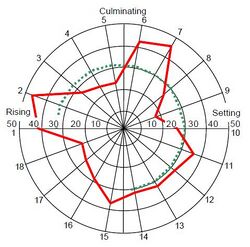
In 1955, astrologer[15] and psychologist Michel Gauquelin stated that although he had failed to find evidence to support such indicators as the zodiacal signs and planetary aspects in astrology, he had found positive correlations between the diurnal positions of some of the planets and success in professions (such as doctors, scientists, athletes, actors, writers, painters, etc.) which astrology traditionally associates with those planets.[14] The best-known of Gauquelin's findings is based on the positions of Mars in the natal charts of successful athletes and became known as the "Mars effect".[16]:213 A study conducted by seven French scientists attempted to replicate the claim, but found no statistical evidence.[16]:213–214 They attributed the effect to selective bias on Gauquelin's part, accusing him of attempting to persuade them to add or delete names from their study.[17]
Geoffrey Dean has suggested that the apparent effect may have been caused by inaccurate self-reporting of birth dates by parents rather than any intentional manipulation of the study results by Gauquelin. The suggestion is that a small subset of the parents may have had changed birth times to be consistent with better astrological charts for a related profession. The sample group was taken from a time when belief in astrology was more common than today. Gauquelin failed to find the Mars effect in more recent populations, in which a nurse or doctor recorded the birth information. The number of births under astrologically undesirable conditions was also lower in the initial study, further indicating that parents had reported dates and times to suit their beliefs.[9]:116
References
- ↑ The level of confidence was self-rated by the astrologers themselves.
- ↑ Also discussed in Martens, Ronny; Trachet, Tim (1998). Making sense of astrology. Amherst, N.Y.: Prometheus Books. ISBN 1-57392-218-8.
- ↑ Slack, Jamie (2021-02-16). "What is Natal Astrology?" (in en-GB). https://jksastrology.com/what-is-natal-astrology/.
- ↑ Sasha Fenton, Understanding Astrology, pp78 - 84, pp141-2, Aquarian Press, London, 1991
- ↑ Jeff Mayo, Teach Yourself Astrology, pp122-23, Hodder and Stoughton, London, 1979
- ↑ Robert Pelletier and Leonard Cataldo, Be Your Own Astrologer, pp44 - 47, Pan Books, London, 1984
- ↑ Robert Pelletier and Leonard Cataldo, Ibid, pp166-68, 1984
- ↑ Sasha Fenton, Ibid, pp68 - 70, 1991
- ↑ Robert Pelletier and Leonard Cataldo, Ibid, pp 162-5, 1984 ; Derek and Julia Parker, The New compleat Astrologer, pp 172-3, Crescent Books, New York, 1990
- ↑ Muller, Richard (2010). "Web site of Richard A. Muller, Professor in the Department of Physics at the University of California at Berkeley,". http://muller.lbl.gov/homepage.html.My former student Shawn Carlson published in Nature magazine the definitive scientific test of Astrology.
Maddox, Sir John (1995). "John Maddox, editor of the science journal Nature, commenting on Carlson's test". http://www.randi.org/encyclopedia/astrology.html. "... a perfectly convincing and lasting demonstration." - ↑ 9.0 9.1 9.2 9.3 Smith, Jonathan C. (2010). Pseudoscience and extraordinary claims of the paranormal : a critical thinker's toolkit. Malden, MA: Wiley-Blackwell. ISBN 978-1-4051-8123-5.
- ↑ Zarka, Philippe (2011). "Astronomy and astrology". Proceedings of the International Astronomical Union 5 (S260): 420–425. doi:10.1017/S1743921311002602. Bibcode: 2011IAUS..260..420Z. https://zenodo.org/record/890932/files/article.pdf.
- ↑ 11.0 11.1 11.2 11.3 Carlson, Shawn (1985). "A double-blind test of astrology". Nature 318 (6045): 419–425. doi:10.1038/318419a0. Bibcode: 1985Natur.318..419C. http://muller.lbl.gov/papers/Astrology-Carlson.pdf.
- ↑ Matthews, Robert (17 Aug 2003). "Astrologers fail to predict proof they are wrong". The Telegraph. https://www.telegraph.co.uk/news/uknews/1439101/Astrologers-fail-to-predict-proof-they-are-wrong.html.
- ↑ 13.0 13.1 13.2 13.3 Dean G., Kelly, I. W. (2003). "Is Astrology Relevant to Consciousness and Psi?". Journal of Consciousness Studies 10 (6–7): 175–198.
- ↑ 14.0 14.1 Gauquelin, Michel (1955). L'influence des astres : étude critique et expérimentale. Paris: Éditions du Dauphin.
- ↑ Pont, Graham (2004). "Philosophy and Science of Music in Ancient Greece". Nexus Network Journal 6 (1): 17–29. doi:10.1007/s00004-004-0003-x.
- ↑ 16.0 16.1 Carroll, Robert Todd (2003). The skeptic's dictionary : a collection of strange beliefs, amusing deceptions, and dangerous delusions. Hoboken, NJ: Wiley. ISBN 0-471-27242-6.
- ↑ Benski, Claude, with a commentary by Jan Willem Nienhuys (1995). The "Mars effect : a French test of over 1,000 sports champions. Amherst, NY: Prometheus Books. ISBN 0-87975-988-7.
Further reading
- Kevin Burk, Astrology: Understanding the Birth Chart. Llewellyn Publications (USA, 2001) ISBN:1-56718-088-4.
 |
